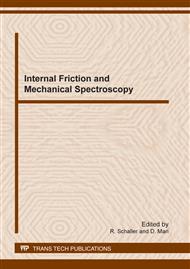p.245
p.251
p.257
p.265
p.271
p.277
p.283
p.289
p.295
High Temperature Internal Friction in Fine Grain and Nano-Crystalline Zirconia
Abstract:
Engineering ceramics are being developed to improve their high-temperature mechanical properties and in particular creep resistance. Recently the production of fine grain ceramics undergoes another step-forward with the development of new technologies to produce nanocrystalline materials. The question is whether the properties depending on the grain size can be extrapolated at nanoscale or, on the contrary, new microscopic mechanisms could appear to be dominant at this nanometer grain size. In the present work we study, by mechanical spectroscopy, the high temperature behavior up to 1350°C of a fine grain Zirconia and a nanocrystalline Zirconia sintered in a conventional way. A new forced torsion pendulum, recently built, has been used for the mechanical spectroscopy measurements. The high temperature background (HTB) of internal friction has been measured as a function of temperature for different frequencies in both materials. The analysis of the HTB shows that the fine grain Zirconia exhibits a single process of defects mobility, with an apparent activation enthalpy similar to the one measured by creep. On the contrary, the HTB of the nanocrystalline sample becomes more complex, showing a much higher energy loss, which will be discussed at the light of the internal friction spectra analysis.
Info:
Periodical:
Pages:
271-276
Citation:
Online since:
January 2012
Price:
Сopyright:
© 2012 Trans Tech Publications Ltd. All Rights Reserved
Share:
Citation:


